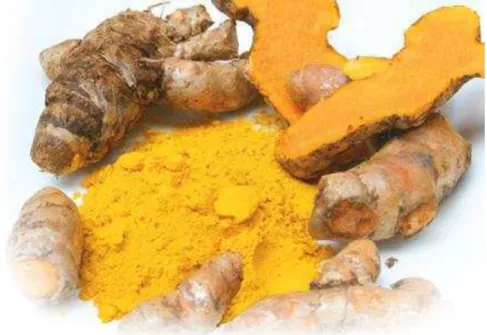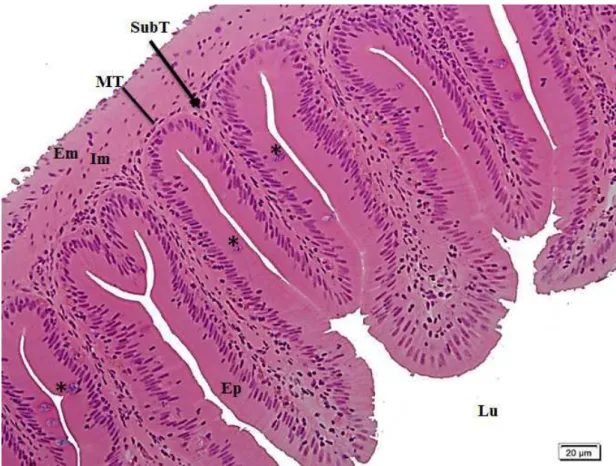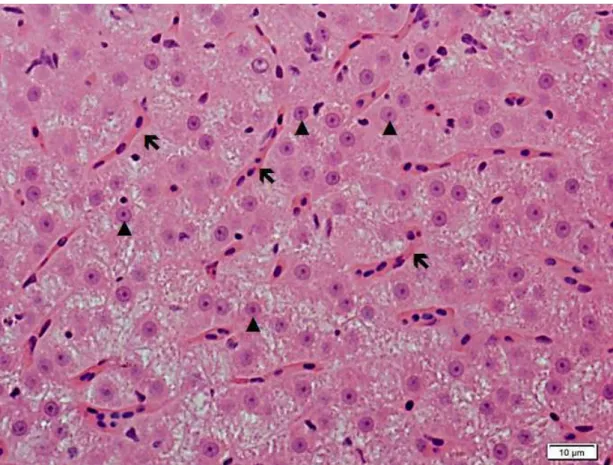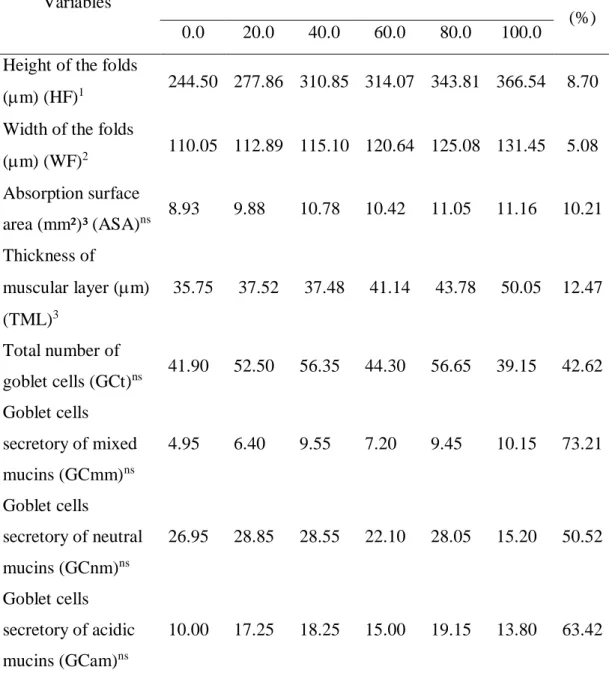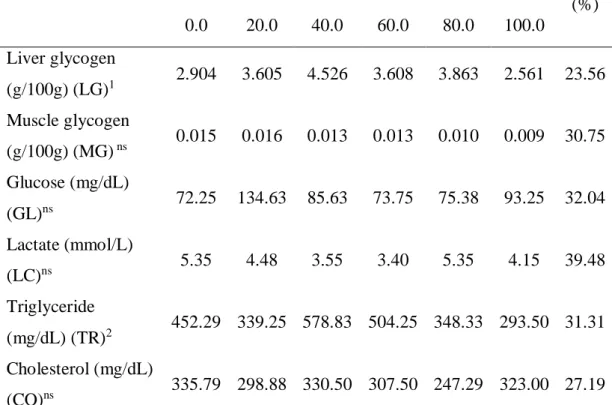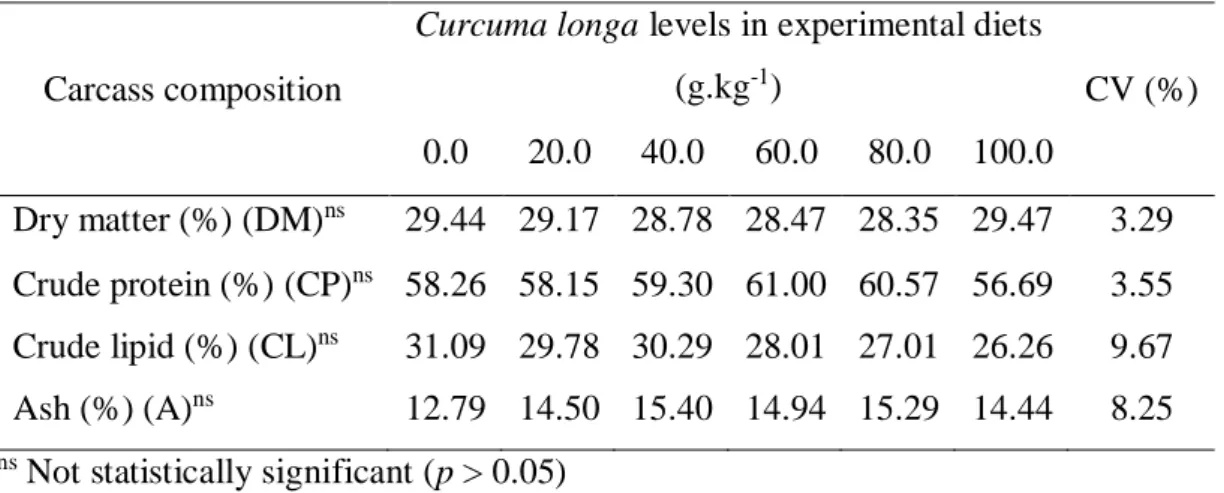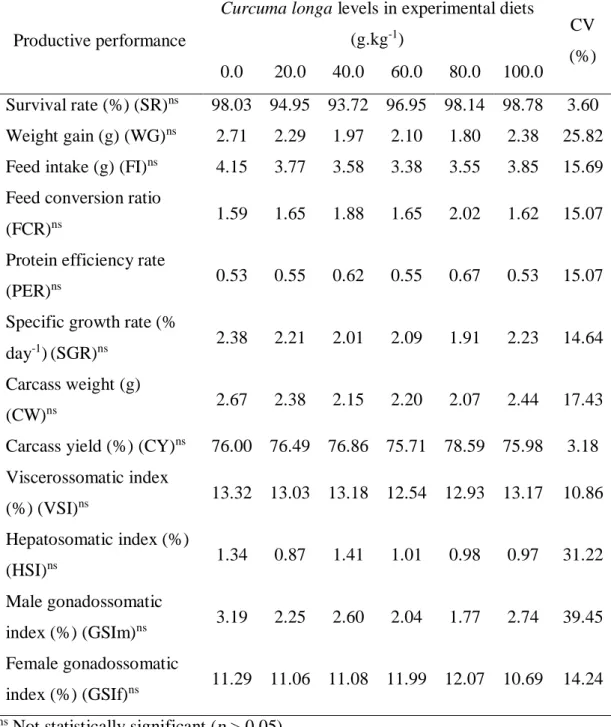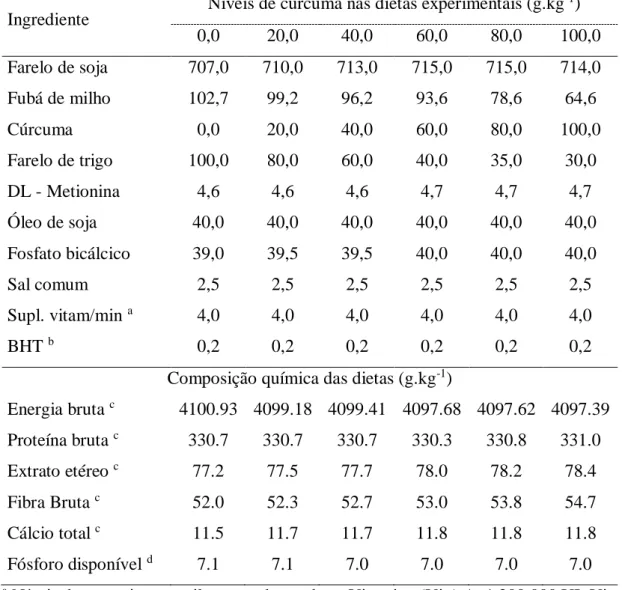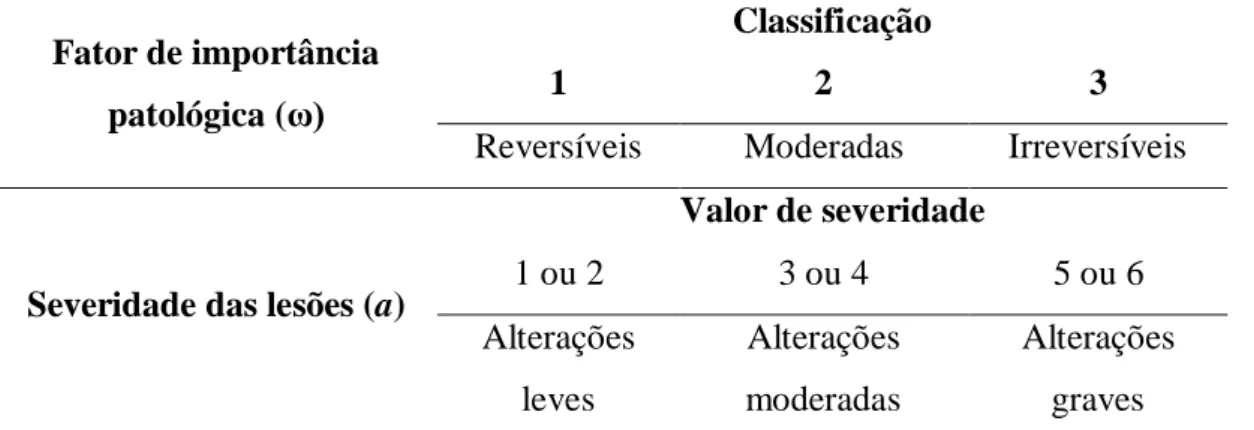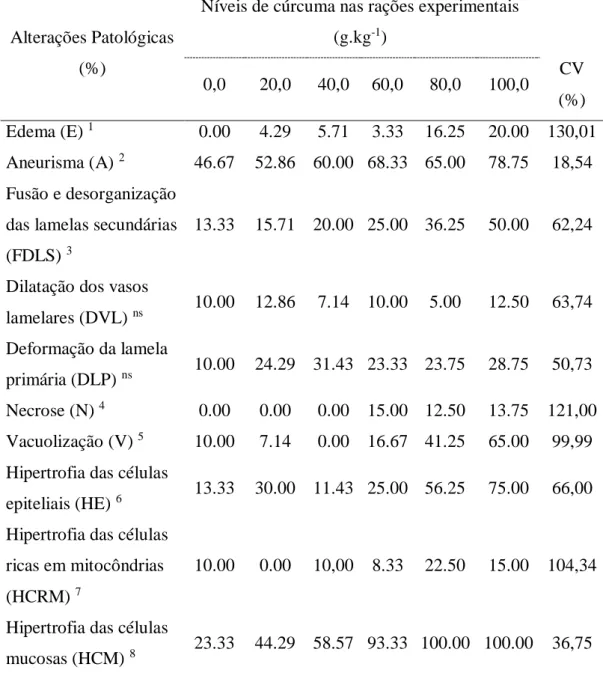POLLYANNA DE MORAES FRANÇA FERREIRA
CÚRCUMA (Curcuma longa) NA DIETA DE Astyanax aff. bimaculatus: SEGURANÇA E EFICÁCIA NA PRODUÇÃO E NO ESTRESSE POR
TRANSPORTE
Tese apresentada à Universidade Federal de Viçosa, como parte das exigências do Programa de Pós-Graduação em Biologia Celular e Estrutural, para obtenção do título de Doctor Scientiae.
VIÇOSA
POLLYANNA DE MORAES FRANÇA FERREIRA
CÚRCUMA (Curcuma longa) NA DIETA DE Astyanax aff. bimaculatus: SEGURANÇA E EFICÁCIA NA PRODUÇÃO E NO ESTRESSE POR
TRANSPORTE
iii
AGRADECIMENTOS
A Universidade Federal de Viçosa (UFV) por intermédio do Departamento de Biologia Geral, pela oportunidade de realização deste curso;
Ao programa de Pós-Graduação em Biologia Celular e Estrutural pela oportunidade de cursar o doutorado;
A Fundação de Amparo á Pesquisa do estado de Minas Gerais (FAPEMIG), pela concessão da bolsa durante a realização deste curso e pelo financiamento do projeto;
Ao Departamento de Biologia Animal e ao Programa de Pós Graduação em Biologia Animal por intermédio dos meus co-orientadores Jener Alexandre Sampaio Zuanon e Ana Lúcia Salaro pelo apoio e pela infra-estrutura fornecida para a execução deste trabalho;
A minha orientadora Juliana Silva Rocha, pela sua disponibilidade em me orientar, pela confiança, pelos conhecimentos compartilhados e incentivos para a realização não apenas do doutorado, mas em todas as outras atividades em paralelo que sempre executei.
Ao meu coorientador Prof. Dr. Jener Alexandre Sampaio Zuanon, penso que esta é a oportunidade ideal para agradecer por tudo aquilo que você fez por mim nesses seis anos de convivência, por tudo o que me ensinou e, também, pelo exemplo de profissional com sua postura séria, honesta e ética, pelo apoio, incentivo e confiança depositados em mim, por toda paciência em muitas vezes ouvir reclamações, lamúrias da minha vida pessoal, mas sempre com um bom conselho. De fato, Jener me faltam palavras pra agradecer e expressar o quanto lhe admiro como profissional e pessoa. Muitíssimo obrigada por tudo.
iv
Ao professor Edenio Detmann, pela disponibilização do Laboratório de Nutrição Animal, do Departamento de Zootecnia para a realização das analises químicas.
Ao professor Jorge Dergan, pela disponibilização do Laboratório de Sistemática Molecular Beagle, do Departamento de Biologia Animal para a realização das fotomicrografias.
Ao professor Mariella Freitas, pela disponibilização do Laboratório de Ecofisiologia de Quirópteros, do Departamento de Biologia Animal para a realização das analises de estresse oxidativo.
Aos professores Sirlene Souza Rodrigues Sartori e Sergio Luis Pinto da Matta que apesar de não serem coorientadores sempre me ajudaram a resolver os problemas que surgiram durante a pesquisa e sempre tiraram minhas dúvidas.
Aos membros da banca examinadora: Edgar de Alencar Teixeira, Mariella Bontempo Duca de Freitas, Sirlene Souza Rodrigues Sartori, Clóvis Andrade Neves pela presença e pelas valiosas sugestões.
Aos Professores que tive durante o doutorado, por todo conhecimento compartilhado;
Aos meus colegas de laboratório e da piscicultura pelos anos de convivência, por toda ajuda e respeito. Em especial a Débora Werneck, Juliana Rodrigues, Maria Tatiana Soares, Alex Cardoso, Jerusa Oliveira, Suellen Condessa, Isabel Neves, Erica Leite, Sendy Reis, Lidiane Nascimento, Marli Cupertino, Uyara Vieira, Mariana Molica, André Ladeira, Renato Ferraz, José Carlos Oliveira, William Chaves, Marcio Kanashiro, Daniel Campelo que tornaram a realização desse trabalho possível.
v
Aos amigos que fiz em Viçosa Ademaria Novais, Rayana Motta, Graziela Domingues pelos bons momentos e apoio nos momentos difíceis.
vi BIOGRAFIA
Pollyanna de Moraes França Ferreira nasceu em 19 de junho de 1986 em Recife – PE, Brasil. Filha de Noberto Luis Martins Ferreira e Ana Márcia de Moraes França Filha.
Em agosto 2009 graduou em Bacharelado em Ciências Biológicas pela Universidade Federal Rural de Pernambuco.
Em 1 de março de 2010 ingressou no Programa de Pós Graduação em Biologia Animal, nível mestrado da Universidade Federal de Viçosa. Defendendo a dissertação em 16 fevereiro de 2012 com o titulo “Óleo essencial de orégano como promotor de crescimento para lambaris-do-rabo-amarelo (Astyanax aff. bimaculatus)”
Em dezembro de 2011 foi aprovada no processo seletivo do Programa de Pós Graduação em Biologia Celular e Estrutural, nível doutorado da Universidade Federal de Viçosa, para ingresso em fevereiro de 2012.
vii SUMÁRIO
Página
LISTA DE TABELAS viii
LISTA DE FIGURAS x
RESUMO xi
ABSTRACT xiii
INTRODUÇÃO GERAL 1
REFERÊNCIAS 7
CAPÍTULO 1- Curcuma longa as a morphophysiologic modulator of the
liver and intestines in Astyanax aff. bimaculatus (Teleostei, Characidae) 20
Abstract 22
Introduction 23
Material and Methods 24
Results 29
Discussion 30
References 34
CAPÍTULO 2 – Altas doses de cúrcuma podem ser tóxicas para peixes? 49
Resumo 50
Introdução 51
Material e Métodos 52
Resultados 57
Discussão 61
Referências 63
CAPÍTULO 3 - Curcuma longa em dietas para Astyanax aff. bimaculatus
como preparativo para o transporte 73
Resumo 74
Introdução 75
Material e Métodos 76
Resultado 80
Discussão 83
Conclusão 84
Referências 84
viii
LISTA DE TABELAS
Página CAPÍTULO 1
Table 1. Formulation of the experimental diets 44 Table 2. Curcuma longa in the intestinal morphology of Astyanax aff.
bimaculatus. 45
Table 3. Curcuma longa on liver morphometry of Astyanax aff.
bimaculatus. 46
Table 4. Energy metabolism of Astyanax aff. bimaculatus fed with
Curcuma longa. 46
Table 5. Carcass composition of Astyanax aff. bimaculatus fed with
Curcuma longa. 47
Table 6. Antioxidant activity in the liver of Astyanax aff. bimaculatus fed
with Curcuma longa. 47
Table 7. Productive performance of Astyanax aff. bimaculatus fed with
Curcuma longa. 48
CAPÍTULO 2
Tabela I. Formulação das dietas experimentais 53
Tabela II: Fator de importância patológica e grau da severidade das lesões. 55 Tabela III: Sistema de classificação dos índices de órgãos calculados
através do histological health index (HHI) (Zimmerli et al., 2007, modificado por Van Dyk et al., 2009)
55
Tabela IV: Frequência das histopatologias (FQ%) encontradas em
Astyanax aff. bimaculatus, alimentados com dietas contendo cúrcuma 58 Tabela V: Índice de brânquias (IBRA) e HHI das patologias encontradas em
Astyanax aff. bimaculatus, alimentados com dietas contendo cúrcuma 59 Tabela VI: Atividade antioxidante nas brânquias de Astyanax aff.
bimaculatus alimentados com dietas contendo cúrcuma 61
CAPÍTULO 3
ix
Tabela 2: Respostas de estresse de Astyanax aff. bimaculatus alimentados
com dietas contendo cúrcuma, após transporte 81
Tabela 3: Atividade antioxidante nas brânquias de Astyanax aff.
bimaculatus alimentados com dietas contendo cúrcuma, após transporte 81 Tabela 4: Atividade antioxidante no fígado de Astyanax aff. bimaculatus
x
LISTA DE FIGURAS
Página
Fig. 1. Rizoma de Curcuma longa 5
CAPÍTULO 1
Fig. 1. Structural organization of the intestine of Astyanax aff. bimaculatus. 42 Fig. 2. Structural organization of liver of the Astyanax aff. bimaculatus. 43
CAPÍTULO 2
Fig. 1. Organização estrutural dos filamentos branquiais de Astyanax aff.
bimaculatus 60
CAPÍTULO 3
Fig. 1. Efeito da cúrcuma sobre a taxa de sobrevivência de Astyanax aff.
xi RESUMO
FERREIRA, Pollyanna de Moraes França, D.Sc., Universidade Federal de Viçosa, fevereiro de 2016. Cúrcuma (Curcuma longa) na dieta de Astyanax aff.
bimaculatus: segurança e eficácia na produção e no estresse por transporte.
Orientadora: Juliana Silva Rocha. Coorientadores: Jener Alexandre Sampaio Zuanon e Ana Lúcia Salaro.
xii
xiii ABSTRACT
FERREIRA, Pollyanna de Moraes França, D.Sc., Universidade Federal de Viçosa, February, 2016. Turmeric (Curcuma longa) in diet of Astyanax aff bimaculatus: safety and efficacy in the production and transport stress. Adviser: Juliana Silva Rocha. Co-Advisers: Jener Alexandre Sampaio Zuanon and Ana Lúcia Salaro.
xiv
1
INTRODUÇÃO GERAL
O uso de plantas medicinais no tratamento e prevenção de doenças é muito antigo ao longo da história da humanidade (Radomski 2003; Almassy Junior 2004). Esse conhecimento popular tem motivado a realização de pesquisas para avaliar a eficácia das propriedades biológicas das plantas medicinais e seus extratos tanto para humanos como para animais de estimação e de produção.
Durante a última década, a atenção tem sido cada vez mais focada no uso de plantas medicinais para promover uma aquicultura sustentável, uma vez que esses produtos podem ser utilizados para diversos fins como: anestésicos (Inoue et al. 2003; Vidal et al. 2007; Ribas et al. 2007), promotores de crescimento (Shalaby et al., 2006; Nya & Austin 2009a,b; Abdel‐Tawwab et al. 2010; Ahmadifar et al. 2011; Ferreira et al. 2014), imunoestimulantes (Rao et al. 2006; Sahu et al. 2007; Sahu et al. 2008; Talpur 2014), na profilaxia e tratamento de doenças (Malheiros 2014; Boijink et al. 2015) e como redutores de estresse (Aly & Mohamed 2010; Zeppenfeld et al. 2014).
Durante a criação de peixes, diversas práticas podem causar estresse aos animais, como por exemplo, manipulação associada a captura e triagem, densidade de estocagem inadequada, transporte, interações biológicas, qualidade da água e manejo de alimentação (Urbinati et al. 2004; Lima et al. 2006; Oba et al. 2009).
2
dissolvido na água (Amend et al. 1982). Essas alterações na qualidade da água representam fatores estressantes para os peixes, podendo causar a mortalidade dos peixes e perdas financeiras aos produtores.
O estresse é um estado fisiológico no qual a homeostase é ameaçada mediante uma mudança ambiental (Squires 2010). As respostas fisiológicas aos fatores estressores permitem que o animal possa lidar com a ameaça ambiental, especialmente durante o estresse agudo. Porém, quando o fator estressor persiste (estresse crônico), as respostas fisiológicas perdem o valor adaptativo e causam mais prejuízos ao bem estar e à homeostase animal (Lima et al. 2006).
3
Dentre as alternativas para minimizar os efeitos do estresse em peixes cultivados destaca-se o uso de extratos vegetais como aditivos em dietas em função destes apresentarem menos efeitos colaterais, menor toxicidade e melhor biodegradabilidade, o que os tornam potencialmente seguros em termos da saúde animal e para o meio ambiente. Em função dos princípios ativos presentes nos extratos vegetais e suas propriedades biológicas, estes também podem ser utilizados para aumentar a produtividade, tendo em vista que os possíveis mecanismos de ação dos extratos vegetais no organismo dos animais são: 1) controle de patógenos pela atividade antimicrobiana (Juven et al. 1994); 2) controle do processo de oxidação por meio da atividade antioxidante (Pulla Reddy & Lokesh 1992; Ramsewak et al. 2000; Balogun et al. 2003; Braga et al. 2003; Priyadarsini et al. 2003; Gülçin 2008; Ramadan et al. 2011); 3) modulação da atividade do sistema imune (Ndong & Fall 2011); 4) melhora na digestão por meio da estimulação da secreção de enzimas digestivas (Mitsch et al. 2004; Rojtinnakorn et al. 2012) e 5) melhora na capacidade de absorção dos nutrientes devido a efeitos benéficos sobre a altura das vilosidades e profundidade das criptas do epitélio intestinal (Bona et al. 2012).
4
113 casos de intoxicação animal por uso de plantas, o que representa 9,42% dos casos de intoxicação animal (SINITOX, 2012).
Dentre os extratos vegetais com potencial para ser utilizado como aditivo em dietas, a Curcuma longa destaca-se por apresentar óleos essenciais como α-felandreno, ρ-cinemo, terpinoleno, 1,8-cineol, curcumeno α-zingibereno, tumerol, sabineno,
borneol, e sesquiterpenos (Chattopadhyay et al. 2004) e pigmentos como curcumina, desmetoxicurcumina e bisdesmetoxicurcumina (Braga et al. 2003; Singh et al. 2011; Sueth-Santiago et al., 2015), que lhe conferem grande diversidade de propriedades biológicas como: anti-inflamatória (Ramadan et al. 2011; Nonose et al. 2014), imunoestimulante (Varalakshmi et al. 2008; Srivastava et al. 2011), antioxidante (Braga et al. 2003; Ramadan et al. 2011), antimicrobiana (Singh et al. 2011; Gaikwad et al. 2014) e anticarcinogênica (Anand et al. 2008; Liu et al. 2013). Além disso, a cúrcuma apresenta efeitos estimulantes da secreção de enzimas digestivas (Pransin 2006), na desintoxicação do organismo (Agarwal et al. 2010), sobre o desenvolvimento do epitélio intestinal (Rajput et al. 2013), sobre o metabolismo dos lipídios (Chattopadhyay et al. 2004; Seo et al. 2008), sobre a secreção de insulina (Wickenberg et al. 2010), sendo hipoglicemiante (Chattopadhyay et al. 2004).
5
cúrcuma é constituído de 6,3% de proteínas, 5,1% de lipídeos, 3,5% de minerais, 69,4% de carboidratos e 13,1% de água (Chattopadhyay et al. 2004).
Fig. 1. Rizoma de Curcuma longa. Fonte: http://en.mr-ginseng.com/turmeric/
Para a utilização da cúrcuma como aditivo em rações para peixes ainda são necessários estudos para avaliar sua eficácia em reduzir respostas de estresse, atuar como imunomodulador e como promotor de crescimento. Dentre esses estudos, ainda incipientes, destacam-se os de Mukherjee et al. (2009), Moreira (2013), Nascimento (2013) e Mahmoud et al. (2014). Além disso, ainda são necessários estudos para avaliar a segurança de seu uso em dietas para peixes. Apesar da maioria dos estudos terem demonstrado que a cúrcuma não é tóxica em dietas para animais e seres humanos (Commandeur & Vermeulen 1996; Cheng et al. 2001; Chauhan 2002; Chainani-Wu 2003; Agarwal et al. 2010; Liju et al. 2013), devido à lixiviação de compostos da dieta na água (Potrich et al. 2011), é possível que os componentes da cúrcuma afetem as brânquias dos peixes, uma vez que estas são órgãos muito sensíveis aos tóxicos presentes na água.
6
para a pesca esportiva (Silva et al. 2011), com franca expansão do mercado como petisco e ainda apresentam potencial para serem comercializados enlatados (Dutra et al. 2012).
O lambari-do-rabo-amarelo, Astyanax aff. bimaculatus (Teleostei, Characidae) distribui-se desde o Nordeste brasileiro até a bacia do Prata (Vilela & Hayashi 2001). É encontrado em uma grande variedade de ambientes, como rios, lagos e riachos. Atinge de 10 a 15 cm de comprimento e até 60 gramas de peso (Porto-Foresti et al. 2010), porém normalmente é comercializado com 8 a 12 cm na forma de isca viva (Sabbag et al. 2011). A atividade reprodutiva se inicia a partir dos 4 meses de idade, apresenta dimorfismo sexual durante o período reprodutivo, sendo as fêmeas maiores, com o corpo arredondado e os machos menores, com o corpo alongado e nadadeira anal com espículas ásperas (Porto-Foresti et al. 2010).
O lambari-do-rabo-amarelo apresenta características positivas para o cultivo como: hábito alimentar onívoro (Adrian et al. 2001) aceitando bem dietas secas, alta taxa reprodutiva e ciclo de produção curto (Porto-Foresti et al. 2010). Além disso, por tratar-se de uma espécie amplamente distribuída, pode ser cultivada em várias regiões do país, sem o risco de introdução de espécie exótica.
7 REFERÊNCIAS
ABDEL‐TAWWAB, M.A.; AHMAD, M.H.; SEDEN, M.E.; SAKR, S.F.M. Use of Green Tea, Camellia sinensis L., in Practical Diet for Growth and Protection of Nile Tilapia, Oreochromis niloticus (L.), against Aeromonas hydrophila Infection. Journal of the World Aquaculture Society. 41(s2): 203-213, 2010. ABELE, D.; VAZQUEZ-MEDINA, J.P.; ZENTENO-SAVIN, T. Oxidative Stress in
Aquatic Ecosystems. John Wiley & Son, 548 p. 2012.
ADRIAN, I.F.; SILVA, H.B.R.; PERETTI, D. Dieta de Astyanax bimaculatus (Linnaeus, 1758) (Characiformes, Characidae), da área de influência do reservatório de Corumbá, Estado de Goiás, Brasil. Acta Sci. 23:435-440, 2001. AGARWAL, R.; GOEL, S.K.; BEHARI, JR. Detoxification and antioxidant effects of curcumin in rats experimentally exposed to mercury. J. Appl. Toxicol. 30(5):457-68, 2010.
AHMADIFAR, E.; FALAHATKAR, B.; AKRAMI, R. Effects of dietary thymol-carvacrol on growth performance, hematological parameters and tissue composition of juvenile rainbow trout, Oncorhynchus mykiss. Journal of Applied Ichthyology. 1(4):1-4, 2011.
ALMASSY JUNIOR, A.A. Análise das características etnobotânicas e etnofarmacológicas de plantas medicinais na comunidade de Lavras Novas, ouro Preto/MG. [Doutorado]. Universidade Federal de Viçosa, 132p. 2004. ALY, S.M. & MOHAMED, M.F. Echinacea purpurea and Allium sativum as
8
AMEND, N.F.; CROV, T.R.; GOVEN. B.A.; JOHNSON, K.A.; MCCARTHY, D.H. Transportation of fish in closed systems: methods to control ammonia, carbon dioxide, pH and bacterial growth. Trans. Am. Fish. Soc. 111:603–611, 1982. ANAND, P.; SUNDARAM, C.; JHURANI, S.; KUNNUMAKKARA, A.B.;
AGGARWA, B.B. Curcumin and cancer: An ‘‘old-age” disease with an
‘‘age-old” solution. Cancer Lett. 267:133-164, 2008.
BALOGUN, E.; HOQUE, M.; GONG, P.; KILLEEN, E.; GREEN, C.; FORESTI, R.; MOTTERLINI, R. Curcumin activates the haem oxygenase-1 gene via regulation of Nrf2 and the antioxidant-responsive element. Biochem. J, 371:887-895, 2003.
BARBOSA, K.B.F.; COSTA, N.M.B.; ALFENAS, R.D.C.G.; DE PAULA, S.O.; MINIM, V.P.R.; BRESSAN, J. Estresse oxidativo: conceito, implicações e fatores modulatórios. Rev. nutr, 23(4):629-643, 2010.
BERNET, D.; SCHMIDT, H.; MEIER, W.; BURKHARDT-HOLM, P.; WAHLI, T. Histopathology in fish: Proposal for a protocol to assess aquatic pollution. Journal of Fish Diseases, 22:25–34, 1999.
BJÖRNSSON, B. Effects of stocking density on growth rate of halibut (Hippoglossus hippoglossus) reared in large circular tanks for three years. Aquaculture Amsterdam, 123:259-270, 1994.
BOIJINK, C.L.; DA CUNHA MIRANDA, W.S.; CHAGAS, E.C.; DAIRIKI, J.K.; INOUE, L.A.K.A. Anthelmintic activity of eugenol in tambaquis with monogenean gill infection. Aquaculture, 438:138-140, 2015.
9
canela e extrato de pimenta no controle de Salmonella, Eimeria e Clostridium em frangos de corte. Pesq. Vet. Bras. 32(5):411-418, 2012.
BRAGA, M.E.M.; LEAL, P.F.; CARVALHO, J.O.E.; MEIRELES, M.A.A. Comparison of Yield, Composition, and Antioxidant Activity of Turmeric (Curcuma longa L.) Extracts Obtained Using Various Techniques. J. Agric. Food Chem., 51:6604-6611, 2003.
CANALLI, L.S. Alteração da microbiota intestinal de frangos de corte pela utilização de probiótico na alimentação. [Doutorado]. Universidade Federal do Paraná, 56p. 1992.
CASO, J.R.; LEZA, J.C.; MENCHEN, L. The Effects of Physical and Psychological Stress on the Gastrointestinal Tract: Lessons from Animal Models. Current Molecular Medicine, 8(4):299-312, 2008.
CECÍLIO FILHO, A.B.; DE SOUZA, R.J.; BRAZ, L.T.; TAVARES, M. Cúrcuma: planta medicinal, condimentar e de outros usos potenciais. Ciência Rural, 30(1), 2000.
CHAINANI-WU, N. Safety and Anti-Inflammatory Activity of Curcumin: A Component of Tumeric (Curcuma longa). The Journal of Alternative and Complementary Medicine, 9(1):161-168, 2003.
CHATTOPADHYAY, I.; BISWAS, K.; BANDYOPADHYAY, U.; BANERJEE, R.K. Turmeric and curcumin: Biological actions and medicinal applications. Curr. Sci., 87(1):44-53, 2004.
CHAUHAN, D.P. Chemotherapeutic Potential of Curcumin for Colorectal Cancer. Curr. Pharm. Des., 8(19):1695-706, 2002.
10
G.S.; CHEN, T.M.; CHEN, C.A.; LAI, M.K.; PU, Y.S.; PAN, M.H.; WANG, Y.J.; TSAI, C.C.; HSIEH, C.Y. Phase I clinical trial of curcumin, a chemopreventive agent, in patients with high-risk or pre-malignant lesions. Anticancer Res., 21(4B):2895-900, 2001.
COMMANDEUR, J.N. & VERMEULEN, N.P. Cytotoxicity and cytoprotective activities of natural compounds. The case of Curcumin. Xenobiotica, 26:667-680, 1996.
CÓRDOVA, A. & NAVAS, F.J. Os radicais livres e o dano muscular produzido pelo exercício: papel dos antioxidantes. Revista Brasileira de Medicina do Esporte, 6(5): 204-208, 2000.
CRUZAT, V.F.; ROGERO, M.M.; BORGES, M.C.; TIRAPEGUI, J. Aspectos atuais sobre estresse oxidativo, exercícios físicos e suplementação. Revista Brasileira de Medicina do Esporte 13(5), 336-342, 2007.
DUTRA, F.M.; MACHADO, W.J.; CAETANO, M.S.; GOBBO, D.A. Avaliação sensorial do processamento em conserva, utilizando-se as espécies: tilápia (Oreochromis niloticus), lambari (Astianax spp) e pacu (Piaractus mesopotamicus). Rev. Bras. Prod. Agroind., 14(3):239-244, 2012.
FERREIRA, P.M.F.; NASCIMENTO, L.S.; DIAS, D.C.; MOREIRA, D.M.V.; SALARO, A.L.; FREITAS, M.B.D.; CARNEIRO, A.P.S.; ZUANON, J.A.S. Essential Oregano Oil as a Growth Promoter for the Yellowtail Tetra, Astyanax altiparanae. Journal of the World Aquaculture Society 45, (1), 2014.
11
GÜLÇIN, T.A.I. Antioxidant and radical scavenging properties of curcumin. Chem. Biol. Interact., 174:27-37, 2008.
HASAN, M.M.; FARUK, M.A.R.; ANKA, I.Z.; AZAD, M.A.K. Investigation on fish health and diseases in rural pond aquaculture in three districts of Bangladesh. Journal of the Bangladesh Agricultural University 11, 377-384, 2014.
HERTWIG, I.F. Plantas aromáticas e medicinais. São Paulo: Icone, Curcuma: p. 254-65. 1986.
INOUE, L.A.K.A.; HACKBARTH, A.; MORAES, G. Benzocaína sobre respostas ao estresse do matrinxã submetido ao transporte em sacos plásticos. Revista Brasileira de Saúde e Produção Animal, 11(3), 2010.
JONES, F.T. Use of Direct-Fed Microbials not New; Way They Work Still not Clear. Feedstuffs. Janeiro, pp. 17-19. 1991.
JUVEN, B.J.; KANNER, J.; SCHVED, F.; WEISSLOWICZ, H. Factors that interact with the antibacterial action of the thyme essential oil and its active constituents. J. App. Bact., 76:626–631, 1994.
LAMBERT, G.P. Stress-induced gastrointestinal barrier dysfunction and its inflammatory effects. Journal of Animal Science, 87(14_suppl):e101-E108, 2008.
LIJU, V.B.; JEENA, K.; KUTTAN, R. Acute and subchronic toxicity as well as mutagenic evaluation of essential oil from turmeric (Curcuma longa L). Food and Chemical Toxicology, 53:52-61, 2013.
12
LIU, T.Y.; TAN, Z.J.; JIANG, L.; GU, J.F.; WU, X.S.; CAO, Y.; LI, M.L.; WU, K.J.; LIU, Y.B. Curcumin induces apoptosis in gallbladder carcinoma cell line GBC-SD cells. Cancer Cell Int, 13(1):64, 2013.
MAHMOUD, M.M.A.; EL-LAMIE, M.M.M.; DESSOUKI, A.A.; YUSUF, M.S. Effect of Turmeric (Curcuma longa) Supplementation on Growth Performance, Feed Utilization, and Resistance of Nile tilapia (Oreochromis niloticus) to Pseudomonas fluorescens Challenge. Glob. Res. J. Fish. Sci. Aquacul., 1(12):026-03, 2014.
MALHEIROS, D.F. Óleo essencial de mentha piperita (lamiaceae) no controle de monogenoideas das brânquias de arapaima gigas (arapaimidae). [Mestrado]. Universidade Federal do Amapá, 57p. 2014.
MARTÍNEZ, M.M.; MARTÍNEZ, M.M.; OCAMPO, D.M.; GALVIS, J.H.; VALENCIA, A. Actividad antibacteriana y citotoxicidad in vivo de extractos etanólicos de Bauhinia variegata L. (Fabaceae). Revista Cubana de Plantas Medicinales, 16(4):313-323, 2011.
MITSCH, P.; ZITTERL-EGLSEER, K.; KOHLER, B.; GABLER, C.; LOSA, R.; ZIMPERNIK, I. The Effect of Two different Blends of Essential Oil Components on the Proliferation of Clostridium perfringens in the Intestines of Broiler Chickens. Poultry Science. 83:669–675, 2004.
MOREIRA, D.M.V. Cúrcuma (Curcuma longa) como pigmentante, promotor de crescimento e da saúde de acará bandeira (Pterophyllum scalare). [Mestrado]. Universidade Federal de Viçosa. 49p. 2013.
13
NASCIMENTO, L.S. Cúrcuma (Curcuma longa) em dietas para juvenis de Trichogaster labiosa. [Mestrado]. Universidade Federal de Viçosa. 59p. 2013. NDONG, D. & FALL, J. The effect of garlic (Allium sativum) on growth and immune responses of hybrid tilapia (Oreochromis niloticus x Oreochromis aureus). Journal of Clinical Immnunology and Immunopathology Research. 3(1):1-9, 2011.
NONOSE, N.; PEREIRA, J.A.; MACHADO, P.R.M.; RODRIGUES, P.R.; SATO, D.T.; MARTINEZ, C.A.R. Oral administration of curcumin (Curcuma longa) can attenuate the neutrophil inflammatory response in zymosan-induced arthritis in rats. Acta Cir. Bras., 29(11):727-734, 2014.
NYA, E.J. & AUSTIN, B. Use of garlic, Allium sativumto control Aeromonas hydrophila infection in rainbow trout, Oncorhynchus mykiss (Walbaum). J. Fish Dis., 617(32):963–970, 2009a.
NYA, E.J. & AUSTIN, B., Use of dietary ginger, Zingiber officinale Roscoe, as an immunostimulant to control Aeromonas hydrophila infections in rainbow trout, Oncorhynchus mykiss (Walbaum). J. Fish Dis., 32:971–977, 2009b.
OBA, E.T.; MARIANO, W.S.; SANTOS, L.R.B. Estresse me peixes cultivados: agravantes e atenuantes para o manejo sustentável. In: TAVARES-DIAS, M. Manejo e sanidade de peixes em cultivo. Embrapa Amapá, Macapá. 2009. OLIVEIRA, L.S.T.; CUNHA E SILVA, S.L.; TAVARES, D.C.; SANTOS, A.V.S.;
OLIVEIRA, G.C.B. Uso de plantas medicinais no tratamento de animais. Enciclopédia Biosfera, 5(8), 2009.
14
piscicultura no Brasil. 2 ed. Santa Maria: Universidade Federal de Santa Maria-UFSM, 1:589-601, 2010.
POTRICH, F.R.; SIGNOR, A.A.; DIETERICH, T.G.; NEU, D.H.; FEIDEN, A.; BOSCOLO, W.R. Estabilidade e lixiviação de nutrientes com rações de diferentes níveis protéicos. Revista Cultivando o Saber, 4:77-87, 2011.
PRANSIN, M. Using Turmeric (Curcuma longa) in Goldfish (Carassius auratus) Feed. [Master of Science]. Kasetsart university. 86p. 2006.
PRIYADARSINI, K.I.; MAITY, D.K.; NAIK, G.H.; KUMAR, M.S.; UNNIKRISHNAN, M.K.; SATAV, J.G.; MOHAN, H. Role of phenolic o-h and methylene hydrogen on the free radical reactions and antioxidant activity of curcumin. Free Radic. Biol. Med., 35(5):475-484, 2003.
PULLA REDDY A.C. & LOKESH B.R. Studies on spice principles as antioxidants in the inhibition of lipid peroxidation of rat liver microsomes. Molecular and Cellular Biochemistry 111(1/2):117-124, 1992.
RADOMSKI, M.I. Plantas medicinais–tradição e ciência. IN: I SEMANA DO ESTUDANTE UNIVERSITÁRIO. FLORESTA E MEIO AMBIENTE, Embrapa, Colombo. 2003.
RAJPUT, N.; NAEEM, M.; RUI, Y.; ZHONG, X.; WANG, T. Effect of dietary supplementation of curcumin on growth performance, intestinal morphology and nutrients utilization of broiler chicks. Jpn. Poult. Sci., 50:44-52, 2013. RAMADAN, G.; AL-KAHTANI, M.A.; EL-SAYED, W.M. Anti-inflammatory and
15
RAMSEWAK, R.S.; DEWITT, D.L.; NAIR, M.G. Cytotoxicity, antioxidant and anti-inflammatory activities of Curcumins I-III from Curcuma longa. Phytom. Medicine., 7(4):303-308, 2000.
RAO, Y.V.; DAS, B.K.; JYOTYRMAYEE, P.; CHAKRABARTI, R. Effect of Achyranthes aspera on the immunity and survival of Labeo rohita infected with Aeromonas hydrophila. Fish & Shellfish Immunology, 20(3):263-73, 2006. RIBAS, L.; FLOS, R.; REIG, L.; MACKENZIE, S.; BARTON, B.A.; TORT, L.
Comparison of methods for anaesthetizing Senegal sole (Solea senegalensis) before slaughter: stress responses and final product quality. Aquaculture, 269(1):250-258, 2007.
RODRIGUES, E.; DUARTE-ALMEIDA, J.M.; PIRES, J.M. Perfil farmacológico e fitoquímico de plantas indicadas pelos caboclos do Parque Nacional do Jaú (AM) como potenciais analgésicas. Parte l. Revista Brasileira de Farmacognosia, 20(6):981-991, 2010.
ROJTINNAKORN, J.; RITTIPLANG, S.; TONGSIRI, S.; CHAIBU, P. Turmeric extract inducing growth biomarker in Sand goby (Oxyeleotris marmoratus). 2nd International Conference on Chemical, Biological and Environment Sciences (ICCEBS'2012) 1, 2012.
SABBAG, O.J.; TAKAHASHI, L.S.; SILVEIRA, A.N.; ARANHA, A.S. Custos e viabilidade econômica da produção de lambari-do-rabo-amarelo em Monte Castelo/SP: um estudo de caso. Boletim do Instituto de Pesca, 37(3):307-315, 2011.
16
SAHU, S.; DAS, B.K.; MISHRA, B.K.; PRADHAN, J.; SAMAL, S.K.; SARANGI, N. Effect of dietary Curcuma longa on enzymatic and immunological profiles of rohu, Labeo rohita (Ham.), infected with Aeromonas hydrophila. Aquaculture research, 39:1720-1730, 2008.
SEGNER, H.; SUNDH, H.; BUCHMANN, K.; DOUXFILS, J.; SUNDELL, K.S.; MATHIEU, C.; RUANE, N.; JUTFELT, F.; TOFTEN, H.; VAUGHAN, L. Health of farmed fish: its relation to fish welfare and its utility as welfare indicator. Fish physiology and biochemistry, 38:85-105, 2012.
SEO, K.; CHOI, M.; JUNG, U.J.; KIM, H.; YEO, J.; JEON, S.; LEE, M. Effect of curcumin supplementation on blood glucose, plasma insulin, and glucose homeostasis related enzyme activities in diabetic db/db mice. Mol. Nutr. Food Res. 52:995-1004, 2008.
SHALABY, A.M.; KHATTAB, Y.A.; ABDEL RAHMAN A.M. Effects of garlic (Allium sativum) and chloramphenicol on growth performance, physiological parameters and survival of nile tilapia (Oreochromis niloticus). Journal of Venomous Animals and Toxins including Tropical Diseases, 12(2):172-201, 2006.
SILVA, N.J.R.; LOPES, M.C.; FERNANDES, J.B.K.; HENRIQUES, M.B. Caracterização dos sistemas de criação e da cadeia produtiva do lambari no estado de São Paulo, Brasil. Informações Econômicas, 41(9):17-28, 2011. SINGH, S.; SANKAR, B.; RAJESH, S.; SAHOO, K.; SUBUDHI, E.; NAYAK, S.
17
SINITOX, Casos Registrados de Intoxicação Humana, de Intoxicação Animal e de Solicitação de Informação por Agente Tóxico. Brasil, 2012. Disponível em: <http://sinitox.icict.fiocruz.br/dados-nacionais>. Acesso em: 26 jan. 2016. SNOW, J.R.; BREWER, D.; WRIGHT, C.F. Plastic bags for shipping sac fry of
largemouth bass. Progressive Fish-Culturist, 40(1):13-16, 1978.
SOUZA-FILHO, J.J. & CERQUEIRA, V.R. Influência da densidade de estocagem no cultivo de juvenis de robalo-flecha mantidos em laboratório. Pesquisa agropecuária brasileira, 38:1317-1322, 2003.
SQUIRES, E.J. Applied animal endocrinology. CABI, 252p. 2010.
SRIVASTAVA, R.M.; SINGH, S.; DUBEY, S.K.; MISRA, K.; KHAR, A. Immunomodulatory and therapeutic activity of curcumin. Int. Immunopharmaco., 11:331-341, 2011.
SUETH-SANTIAGO, V.; MENDES-SILVA, G.P.; DECOTÉ-RICARDO, D.; LIMA, M.E.F. Curcumina, o pó dourado do açafrão-da-terra: introspecções sobre química e atividades biológicas. Química Nova, 38(4):538-552, 2015. SUZUKI, K.; HARASAWA, R.; YOSHITAKE, Y.; MITSUOKA, T. Effects of
Crowding and Heat Stress on Intestinal Flora, Body Weight Gain, and Feed Efficiency of Growing Rats and Chicks. The Japanese Journal of Veterinary Science, 45(3):331-338, 1983.
18
URBINATI, E.C.; ABREU, J.S.; CAMARGO, A.C.S.; LANDINEZ, M.A. Loading and transport stress of juvenile matrinxã (Brycon cephalus, Characidae) at various densities. Aquaculture, 229:389–400, 2004.
VARALAKSHMI, C.H.; ALI, A.M.; PARDHASARADHI, B.V.; SRIVASTAVA, R.M.; SINGH, S.; KHAR, A. Immunomodulatory effects of curcumin: In-vivo. Int. Immunopharmaco, 8:688–700, 2008.
VIDAL, L.V.O.; FURUYA, W.M. M.; GRACIANO, T.S.; SCHAMBER, C.R.; DA SILVA, L.C.R.; DOS SANTOS, L.D.; DE SOUZA, S.R. Eugenol como anestésico para juvenis de matrinxã (" Brycon cephalus"). Revista Brasileira de Saúde e Produção Animal, 8(4), 2007.
VILELA, C. & HAYASHI, C. Desenvolvimento de juvenis de lambari Astyanax bimaculatus (Linnaeus, 1758), sob diferentes densidades de estocagem em tanques-rede. Acta Scientiarum, 23(2):491-496, 2001.
VOLLMANN-SCHIPPER, F. Transport de Peces Vivos. Editora Acribia, Zaragoza, 90p. 1978.
WENDELAAR BONGA, S.E. The stress response of fish. Physiological Reviews, 77:591-645, 1997.
WICKENBERG, J.; INGEMANSSON, S.L.; HLEBOWICZ, J. Effects of Curcuma longa (turmeric) on postprandial plasma glucose and insulin in healthy subjects. Nutr. J., 9:43p, 2010.
19
water with essential oil of Aloysia triphylla (L'Herit) Britton. Aquaculture, 418–419:101–107, 2014.
20
CAPÍTULO 1 - Curcuma longa as a morphophysiologic modulator of the liver and intestines in Astyanax aff. bimaculatus (Teleostei, Characidae)
21
Curcuma longa as a morphophysiologic modulator of the liver and intestines in
Astyanax aff. bimaculatus (Teleostei, Characidae)
Running title: Turmeric in liver and gut of A. bimaculatus
Keywords: curcumin, energy metabolism, histology, growth promoter, oxidative stress, plant extracts.
Summary statement:
22 ABSTRACT
23 INTRODUCTION
Turmeric (Curcuma longa) stands out in disease prevention and health promotion in both humans and animals (Cheng et al., 2001; Anand et al., 2008; Huang et al., 2015) because it is rich in essential oils (tumerona, α- tumerona and β- zingiberene) and pigments (curcumin, demethoxycurcumin and bisdemethoxycurcumin) (Braga et al., 2003; Singh et al., 2011.). It offers a wide range of biologic properties, being considered as an anti-inflammatory (Ramadan et al., 2011; Nonose et al., 2014), immune stimulant (Varalakshmi et al., 2008; Srivastava et al., 2011.), antioxidant (Braga et al., 2003; Ramadan et al., 2011) and antimicrobial (Singh et al., 2011; Gaikwad et al., 2014.). In addition, tumeric has stimulating effects on the secretion of digestive enzymes (Pransin, 2006), body detoxification (Agarwal et al., 2010), the development of intestinal epithelium (Rajput et al., 2013), lipid metabolism (Chattopadhyay et al., 2004; Seo et al., 2008), insulin secretion (Wickenberg et al., 2010) and on anti-diabetic agents (Chattopadhyay et al., 2004).
The use of plant extracts in diet has beneficial effects for the metabolism and growth of animals and to the integrity of tissues and organs. Due to the small number of products approved for use in the cultivation of aquatic organisms, it is essential to search for natural products with fewer side effects, less toxicity and better biodegradability than antibiotics, which would make them safer in terms of human health, animal health and the environment.
Knowledge of gastrointestinal histology and the process of digestion and absorption of nutrients is essential for understanding the relationship between physiology and fish nutrition. Such knowledge may contribute to the development of more adequate diets and thus increase productivity and reduce production costs (Castro et al., 2002; Faccioli et al., 2014). In addition, the nutrients of a diet can directly affect the function and morphology of the liver, important in energy metabolism, lipid emulsification and detoxification of the body (Bombardelli et al., 2009).
24
high reproductive rate without hormonal induction and short production cycle (Porto-Foresti et al., 2010).
Thus, the present study aimed to evaluate turmeric (Curcuma longa) as a morphophysiologic modulator of intestinal and hepatic tissues of A. aff. bimaculatus and its role in growth and carcass quality of these animals.
MATERIAL AND METHODS
Animals and experimental conditions
The experiment was approved by the Ethics Committee for Animal Use (CEUA) of the Federal University of Viçosa (Protocol 93/2013). It used a completely randomized design with six treatments and four replications. Treatments consisted of six isonitrogenous and isocaloric diets (Table 1) containing 0.00, 20.0, 40.0, 60.0, 80.0 and 100.0 g.kg-1 turmeric rhizome.
The Curcuma longa powder was premixed with the other ingredients of the diet. The mixture was pelletized, dried in a forced air oven (40 °C for 24 h), broken into small pieces, sieved and stored at -20 °C.
Juveniles of A. aff. bimaculatus with an average weight of 0.83 ± 0.04 g were kept in aquariums containing 80 L of water, which were fitted with aeration and biological filters, and temperature controlled by heaters and thermostats (27 °C). The stocking density was 40 fish / aquarium (0.5 fish.L-1 water).
The fish were fed to satiation three times daily for 90 days. At the end of the trial period, the fish were euthanized by excess anesthetic (clove oil 400 mg.L-1) to collect the samples.
25 Intestinal and hepatic histomorphometry
Histologic analyses were performed at the Laboratory of Cell Biology and Structural Department of General Biology of Federal University of Viçosa. Livers and intestines of two fish from each experimental unit (eight fish / treatment) were used. The intestines (anterior portion) and whole livers were fixed in Karnovsky fixative solution (Karnovsky, 1965) for 24 h at room temperature, transferred to 70% ethanol, dehydrated in an ascending series of ethanol and embedded in glycol methacrylate (Historesin®, Leica, Germany). Semi-serial sections of 3 m thick were made with an interval of 30 μm obtained by a rotary microtome (Leica, Germany), using glass knives. Sections were fixed on glass slides and processed for staining with hematoxylin and eosin. They were visualized under a light microscope for an initial tissue scan for possible morphologic changes and also for morphometric analysis. The intestines were subjected to histochemistry analysis using periodic acid-Schiff (PAS) staining in conjunction with alcian blue (AB), for detection of acidic and neutral mucopolysaccharides, and the livers were submitted to PAS staining for the detection of liver glycogen. Histologic preparations were mounted with Entellan® (Merck, Frankfurt, Germany), photo documented with the Olympus BX53 light microscope (Tokyo, Japan) with the Olympus DP73 camera attached and analyzed by the image analysis software Image-Pro Plus 4.5® (Media Cybernetics, Rockville, MD, USA).
In the morphometric analysis of the intestines, the height and width of the folds and the thickness of the muscular tunic were measured. The height of the fold (HF) was taken from its base to the apex, in five folds for each image (50 measurements per animal). The width of the fold (WF) was taken in the same five folds in two points, one closer to the apex and the other closer to the base (100 measurements per animal). For the thickness of the muscular tunic (TMT), the inner and outer muscle layers together were measured at two points per image (20 measurements per animal). The absorption surface area (ASA) was calculated according to the formula given by Kisieliński et al. (2002) with the following adaptation:
ASA = (fold width x fold height) / (fold width / 2)2.
26
The liver morphometric analysis was performed on 10 fields per animal. The proportion of liver components including the cytoplasm and nucleus of hepatocytes and sinusoidal capillaries was determined using a checkered grid of 289 points (2890 points per animal), with numbered points (intersections of lines) on the nuclei and cytoplasm of hepatocytes and on capillary sinusoids. The diameters of 20 nuclei from each image were also measured, totaling 200 nuclei per animal.
Energy metabolism
Glucose, lactate, triglyceride and cholesterol blood levels were measured by test strips in the digital display devices Accutrend® Plus and Accu-Chek ACTIVE® (Roche, Brazil). Blood was collected by cutting the tail fin peduncle with a scalpel from two fish of each experimental unit (eight fish / treatment).
To determine liver and muscle glycogen concentration, liver samples were pooled (from ten fish / aquarium) to obtain a minimum of 100 mg of sample, and muscle samples were collected from two fish per aquarium. The samples were collected in centrifuge tubes containing 30% KOH. The samples were hydrolyzed in a boiling water bath for one hour, with five drops of saturated Na2SO4 withdrawal from the bath. The tubes were then centrifuged at 840 g for 10 minutes. The supernatant was discarded, and the liver and muscle glycogen concentrations were measured by the colorimetric method described by Sjörgren et al. (1938), by spectrophotometry at 620 nm.
Carcass chemical composition
To evaluate the chemical composition of the carcass, a sample was collected from 15 fish from each experimental unit (60 fish / treatment). It was considered carcass, the fish gilled and scales. The crude protein, dry matter, crude lipid and total ash were assessed according to the protocol by Detmann et al. (2012).
Antioxidant activity
27
were pooled (from ten fish / aquarium) to obtain the minimum amount of sample (100 mg). These samples were homogenized in phosphate buffer (pH 7.4) and the suspension centrifuged (3500 g at 4 °C for 10 min).
The total protein concentration of homogenate was measured in an ELISA reader at 700 nm according to Lowry et al. (1951), using bovine serum albumin as a standard, and the results were expressed in mg of protein per g of tissue. The concentration of total protein was used to express the data of the enzymes CAT and SOD, and the malondialdehyde (MDA) concentration in mg of protein (prt).
The activity of catalase (CAT) were determined by the hydrogen peroxide decay rate (10 mmol.L-1) in a spectrophotometer at 240 nm for 60 s (Aebi, 1984). Catalase activity was expressed in units (U) CAT / mg prt.
The activity of superoxide dismutase (SOD) was determined in an ELISA reader at 570 nm according to Dieterich et al., 2000, with modifications, based on the ability of this enzyme to catalyze the reaction of superoxide (O2-) into hydrogen peroxide and thus decrease the ratio of self-oxidation of pyrogallol. The activity of SOD was expressed in U SOD / mg prt.
The activity of glutathione-S-transferase (GST) was measured through the formation of glutathione-2,4-dinitrobenzene which was estimated by the change in absorbance at 340 nm for 60 sec, in a spectrophotometer. The formation of the conjugate occurs spontaneously on the substrate 1-chloro-2,4-dinitrobenzene (CDNB) in a non-enzymatic reaction and is accelerated by GST enzyme activity. One unit of GST is the amount of enzyme which forms 1 mol of glutathione-2,4-dinitrobenzene conjugate per minute. The molar extinction coefficient 340 = 9.6 mM CDNB-1.cm-1 was used for calculation (Habig et al., 1974). The GST activity was expressed as μmol min-1.g-1.
28 Productive performance
The fish were counted and weighed for calculation of the following variables of productive performance:
Survival rate (SR) = initial number of fish/final number of fish × 100; Weight gain (WG) = average final weight - average initial weight;
Feed intake (FI) = (weight of initial feed − weight of finished feed) / number of fish; Feed conversion ratio (FCR) = FI/WG;
Protein efficiency ratio (PER) = weight gain/protein intake;
Specific growth rate (SGR), using the equation shown below (Ricker, 1979): 100 ) ( ) ( ln ) ( ln x day time g WI g WF
SRG ;
WI = initial weight of fish (g); WF = final weight of fish (g);
Carcass Yield (CY) = (carcass weight (CW)/final weight (FW)) × 100; Viscero-somatic index (VSI) = (weight of viscera/body weight) × 100; Hepatosomatic index (HSI) = (liver weight / body weight) × 100;
Male gonadosomatic index (GSIm) = (testes weight / body weight) × 100; Female gonadosomatic index (GSIf) = (weight of ovaries / body weight) × 100.
Statistical analysis
29 RESULTS
Intestinal and hepatic histomorphometry
Histologic analysis of the intestine of A. aff. bimaculatus revealed that the intestinal wall was composed of four coats: the mucosa, submucosa, muscularis and serosa. In the inner lining there were folds formed by projections of the mucosa and submucosa layers. The mucosa of this organ contained simple columnar epithelial tissue with brush border and goblet cells. The muscle layer was formed of two layers of smooth muscle: internal (circular) and external (longitudinal) (Fig. 1). Very vascular pancreatic tissue was found near the intestinal tract, indicating that these animals have a diffuse pancreas.
We observed an increasing linear effect of turmeric on intestinal components such as height of the folds (HF), width of the folds (WF) and thickness of the muscular layer (TML). (Fig. 1)There was no effect of turmeric on the absorption surface area (ASA), the total number of goblet cells (GCt), the number of goblet cells secreting mixed mucins (GCmm), the number of goblet cells secreting neutral mucins (GCnm) or the number of goblet cells secreting acidic mucins (GCam) (Table 2).
30 Energy metabolism
There was a quadratic effect of turmeric on liver glycogen and blood triglycerides. The values that maximized these variables were 45.00 and 39.60 g turmeric.kg-1, respectively. However, the result of turmeric on triglycerides was disregarded in view of the low value of R². For muscle glycogen, glucose, lactate and blood cholesterol, there was no significant effect of turmeric levels in the diet (Table 4).
Carcass composition
There was no effect of turmeric on dry matter, crude protein, ether extract or ash in the carcass (Table 5).
Antioxidant activity
There were no effects of turmeric on the enzyme activities of SOD, CAT, GST or the concentration of the product of lipid peroxidation (MDA) in the fish livers (Table 6).
Productive performance
There was no effect of turmeric on WG, CW, SGR, SR, FI, FCR, PER, CY, VSI, HSI, GSIm or GSIf (Table 7).
DISCUSSION
31
of enterocytes and hence greater amounts of enzyme in the brush border and a larger contact area for nutrient absorption, which could increase fish growth. However, in this study, there were no effects of turmeric on the productive performance of the animals. Mahmoud et al. (2014) did not observe improvement in the growth performance of tilapia fed with 2.5 or 5.0 g.kg-1 turmeric for three months. When these animals were exposed to the bacteria Pseudomonas fluorescens, the turmeric helped reducing intestinal and liver damage. However, Rajput et al. (2013) observed that broilers fed with 200 mg.kg-1 of curcumin for 42 days showed an increased absorption area of the small intestinal villi, resulting in improved nutrient absorption and body growth.
The mechanisms of action of turmeric related to the increased thickness of the intestinal muscularis are still unclear. However, this effect may be related to its actions as an insulin agonist and a stimulant of insulin secretion (Wickenberg et al., 2010; Ghorbani et al., 2014), since Horváth et al. (2006) found insulin receptors in the muscular wall of the digestive tract in rats, and Charlton et al. (2000) reported that insulin stimulates protein synthesis in the mucous layer of the human intestines. However, there are conflicting results in the literature as Arshami et al. (2013) reported an increase in the thickness of the muscular layer in hens fed with turmeric, while Maneewan et al. (2012) reported a reduction in the thickness of the muscular layer in the duodenum of pigs fed with turmeric.
The lack of effect of turmeric on GCt, GCmm, GCnm and GCam in A. aff. bimaculatus observed in this study was consistent with the results observed by Kumar et al. (2012), who found that there was no effect of turmeric on the number of goblet cells per crypt in albino Wistar rats. In addition, the lack of effect of turmeric on the number of goblet cells may be related to the fact that turmeric does not irritate the intestinal mucosa (Labban, 2014), and thus does not stimulate mucus secretion by goblet cells.
32
glycogen synthesis. Moreover, as turmeric is rich in flavonoids (isoflavones) (Gaikwad et al., 2014), and these substances have hypoglycemic activity (Cheng et al., 2004), turmeric may have directly stimulated liver glycogen synthesis in A. aff. bimaculatus. Bustanji et al. (2009) observed that in albino Wistar rats that received injections of curcumin, there was an increase in liver glycogen due to inhibition of the enzyme glycogen synthase kinase 3 beta (GSK-3B). The reduction of sinusoid capillaries in the liver, observed in this study, confirmed the observation that curcumin has an antiangiogenic effect on tissues and organs such as adipose tissue (Ejaz et al., 2009), the peritoneal lining (Gururaj et al., 2002), the cornea (Arbiser et al., 1998; Mohan et al., 2000) and tumors (Bhandarkar and Arbiser, 2007). This effect of curcumin is due to a decreased expression of genes associated with angiogenesis, such as vascular endothelial growth factor (VEGF) and gelatinase B (MMP-9) (Hahm et al., 2004). The lower capillarization in the fish livers which received higher doses of turmeric (above 45.00 gkg-1) may explain the lower glycogen deposition, since the liver had less blood flow which decreased the amount of substrate for the synthesis of glycogen.
Turmeric has antioxidant action due to the ability of curcumin to scavenge free radicals, inhibit lipid peroxidation and maintain the activity of the antioxidant enzymes SOD and CAT (Pulla Reddy and Lokesh, 1992; Ramsewak et al., 2000; Priyadarsini et al., 2003; Gülçin, 2008; Manju et al., 2012). However, in this study, there was no significant effect of turmeric on lipid peroxidation or on the activity of enzymes evaluated in the fish livers. This may be related to the fact that the animals were not under adverse conditions (stress) which generates free radicals and reactive oxygen species (ROS), such as occurs by routine management of fish farming (Azambuja et al., 2011; Zeppenfeld et al., 2014), environmental pollution by heavy metals (Ahmad et al., 2000; Farombi et al., 2007; Condessa, 2014) and insecticides (Sayeed et al., 2003; Monteiro et al., 2006).
33
In conclusion, this study showed that Curcuma longa has trophic effects on the epithelium and the muscular layer of the intestines of A. aff. bimaculatus. Additionally, low levels of Curcuma longa cause increased deposition of liver glycogen and high levels cause a reduction.
Acknowledgment
The authors thank the Guabi Nutrição Animal, Brazil, for its support in performing these experiments successfully. The authors are also very grateful to Mariella Freitas coordinator of the Cell Culture and Ecophysiology Laboratory of Department of Animal Biology - UFV, for providing the laboratory for the oxidadive stress and glycogen analysis, and to Edenio Detmann coordinator of the Nutrition Monogastric Laboratory of Department of Animal Husbandry – UFV, for the analysis of chemical composition of carcass and diets.
Competing interests
The authors declare no competing or financial interests.
Author contributions
P.M.F.F. designed the project, conducted experiments, analysed the data, and wrote the manuscript. M.T.S., D.W.C and J.R.G. conducted experiments. J.M.O. performed and analysed the oxidative stress data and edited the manuscript. A.L.S. and J.S.R. edited the manuscript. J.A.S.Z conceived and designed the experimental approach and wrote the manuscript. All authors contributed to data discussion and to revising the original manuscript.
Funding
34 References
Adrian, I. F., Silva, H. B. R. and Peretti, D. (2001). Dieta de Astyanax bimaculatus (Linnaeus, 1758) (Characiformes, Characidae), da área de influência do reservatório de Corumbá, Estado de Goiás, Brasil. Acta Sci. 23:435-440.
Aebi, H. (1984). Catalase in vitro. Methods Enzymol. 105:121-126.
Agarwal, R., Goel, S. K. and Behari, JR. (2010). Detoxification and antioxidant effects of curcumin in rats experimentally exposed to mercury. J. Appl. Toxicol. 30(5):457-68.
Ahmad, I., Hamid, T., Fatima, M., Chand, H. S., Jain, S. K., Athar, M. and Raisuddin, S. (2000). Induction of hepatic antioxidants in freshwater catfhsh (Channa punctatus Bloch) is a biomarker of paper mill effluent exposure. Biochim. Biophys. Acta. 1523:37-48.
Allen, P. C., Danforth, H. D. and Augustine, P. C. (1998). Dietary modulation of avian coccidiosis. Int. J. Parasitol. 28:1131-1140
Anand, P., Sundaram, C., Jhurani, S., Kunnumakkara, A.B. and Aggarwa, B. B. (2008). Curcumin and cancer: An ‘‘old-age” disease with an ‘‘age-old” solution. Cancer Lett. 267:133-164.
Araújo, C. C. A. and Leon, L. L. (2001). Biological Activities of Curcuma longa L. Mem. Inst. Oswaldo Cruz. 96(5):723-728
Arbiser, J. L., Klauber, N., Rohan, R., Van Leeuwen, R., Huang, M. T., Fisher, C., Flynn, E. and Byers, H. R. (1998). Curcumin is an in vivo inhibitor of angiogenesis. Mol. Med. 4:376-383.
Arshami, J., Pilevar, M., Azghadi, M. A. and Raji, A. R. (2013). Hypolipidemic and antioxidative effects of curcumin on blood parameters, humoral immunity, and jejunum histology in Hy-line hens. Avicenna J. Phytomed. 3(2):178-185. Azambuja, C. R., Mattiazzi, J., Riffel, A. P. K., Finamor, I. A., Garcia, L. O.,
Heldwein, C. G., Heinzmann, B. M., Baldisserotto, B., Pavanato, M. A. and Llesuy, S. F. (2011). Effect of the essential oil of Lippia alba on oxidative stress parameters in silver catfish (Rhamdia quelen) subjected to transport. Aquacult. 319:156-161.
35
Bombardelli, R. A., Hayashi, C., Natali, M. R. M., Sanches, E. A. and Piana, P. A. (2009). Desempenho reprodutivo e zootécnico e deposição de lipídios nos hepatócitos de fêmeas de tilápia-do-nilo alimentadas com rações de diversos níveis energéticos. R. Bras. Zootec. 38(8):1391-1399.
Braga, M. E. M., Leal, P. F., Carvalho, J. O. E. and Meireles, M. A. A. (2003). Comparison of Yield, Composition, and Antioxidant Activity of Turmeric (Curcuma longa L.) Extracts Obtained Using Various Techniques. J. Agric. Food Chem. 51:6604-6611.
Buege, J. A. and Aust, S. D. (1978). Microsomal lipid peroxidation methods. Enzymol. 52:302-310.
Bustanji, Y., Taha, M. O., Almasri, I. M., Al-Ghussein, M. A., Mohammad, M. K. and Alkhatib, H. S. (2009). Inhibition of glycogen synthase kinase by curcumin: Investigation by simulated molecular docking and subsequent in vitro/in vivo evaluation. J. Enzyme Inhib. Med. Chem. 24(3):771-8.
Campelo, D. A.V., Oliveira, K. R. B., Batiston, W. P., Zuanon, J. A. S., Furuya, W. M., Matsushita, M. and Salaro, A. L. (2014). Conjugated linoleic acid in diets for lambari (Astyanax altiparanae). Aquacult. Nutr. 1:16.
Castro, E. F., Fonseca, C. C. and Menin, E. (2002). Identificação de células endócrinas no aparelho digestório de Prochilodus marggravii Walbaum, 1792 (Pisces, Teleostei, Characiformes, Prochilodontidae). Arq. ciênc. vet. zool. UNIPAR 5(1):71-78.
Charlton, M., Ahlman, B. and Nair, K. S. (2000). The Effect of Insulin on Human Small Intestinal Mucosal Protein Synthesis. Gastroenterology. 118(2):299-306. Chattopadhyay, I., Biswas, K., Bandyopadhyay, U. and Banerjee, R. K. (2004).
Turmeric and curcumin: Biological actions and medicinal applications. Curr. Sci. 87(1):44-53.
Chauhan, D. P. (2002). Chemotherapeutic Potential of Curcumin for Colorectal Cancer. Curr. Pharm. Des. 8(19):1695-706.
Chaves, W. (2014). Relação Macho e Fêmeas na Reprodução de Lambaris. Monografia (Graduação em Zootecnia). Universidade Federal de Viçosa, MG. Cheng, A. L., Hsu, C. H., Lin, J. K., Hsu, M. M., Ho, Y. F., Shen, T. S., Ko, J. Y.,
36
chemopreventive agent, in patients with high-risk or pre-malignant lesions. Anticancer Res. 21(4B):2895-900.
Cheng, S. Y., Shaw, N. S., Tsai, K. S. and Chen, C. Y. (2004). The hypoglycemic effects of soy isoflavones on postmenopausal women. Res. J. Womens Health. 13(10):1080-6.
Commandeur, J. N. and Vermeulen, N. P. (1996). Cytotoxicity and cytoprotective activities of natural compounds. The case of Curcumin. Xenobiotica. 26:667-680. Condessa, S. S. (2014). Estresse oxidativo causado pelo cromo hexavalente e ação da vitamina C em Astyanax aff. bimaculatus (teleostei: characidae) machos adultos e potencial biossortivo da casca de coco verde (Cocos nucifera l.). Tese (Doutorado em Biologia Celular e Estrutural). Universidade Federal de Viçosa, Viçosa, MG. 203p.
Cyrino, J. E. P., Portz, L. and Martino, R. C. (2000). Retenção de proteína e energia em juvenis de "black bass" Micropterus salmoides. Sci. agric. 57(4):609-616. Detmann, E., Souza, M. A., Valadares, Filho S. C., Queiroz, A. C., Berchielli, T.
T., Saliba, E. O. S., Cabral, L. S., Pina, D. S., Pina, D. S., Ladeira, M. M. and Azevedo, J. A. G. (2012). Métodos para análise de alimentos. Ed. Suprema, Visconde de Rio Branco, MG.
Dieterich, S., Bieligk, U., Beulich, K., Hasenfuss, G. and Prestle, J. (2000). Gene expression of antioxidative enzymes in the human heart: increased expression of catalase in the end-stage failing heart. Circulation. 101:33-9.
Dutra, F. M., Machado, W. J., Caetano, M. S. and Gobbo, D. A. (2012). Avaliação sensorial do processamento em conserva, utilizando-se as espécies: tilápia (Oreochromis niloticus), lambari (Astianax spp) e pacu (Piaractus mesopotamicus). Rev. Bras. Prod. Agroind. 14(3):239-244.
Ejaz, A., Wu, D., Kwan, P. and Meydani, M. (2009). Curcumin Inhibits Adipogenesis in 3T3-L1 Adipocytes and Angiogenesis and Obesity in C57/BL Mice1–3. J Nutr. 139(5):919-25.
Faccioli, C. K., Chedida, R. A., Amarala, A. C., Vicentinia, I. B. F. and Vicentini, C. A. (2014). Morphology and histochemistry of the digestive tract in carnivorous freshwater Hemisorubim platyrhynchos (Siluriformes: Pimelodidae). Micron. 64:10-19.
37
cat fish (Clarias gariepinus) from Nigeria Ogun River. Int. J. Environ. Res. Public. Health. 4(2):158-65.
Gaikwad, A., Bodhankar, M., Ittadwar, A. and Waikar, S. (2014). Antibacterial activity of isoflavone extracted from Curcuma longa linn. Zingeberaceae. ISOI J. Microbiol. Biotech. Food Sci. 1(1):06-09.
Ghorbani, Z., Hekmatdoost, A. and Mirmiran, P. (2014). Anti-Hyperglycemic and Insulin sensitizer Effects of Turmeric and Its Principle Constituent Curcumin. Int. J. Endocrinol. Metab. 12(4): e18081.
Gülçin, T. A. I. (2008). Antioxidant and radical scavenging properties of curcumin. Chem. Biol. Interact. 174:27-37.
Gururaj, B. M. A. E., Venkatesh, D. A., Marmé, D. and Salimath, B. P. (2002). Molecular mechanisms of anti-angiogenic effect of curcumin. Biochem. Biophys. Res. Commun. 297(4):934-942.
Habig, W. H., Pabst, M. J. and Jakoby, W. B. (1974). Glutathione-S-Transferases: The First Enzymatic Step In Mercapturic Acid Formation. J. Biol. Chem. 249(22):7130-7139
Hahm, E. R., Gho, Y. S., Park, S., Park, C., Kim, K. W. and Yang, C. H. (2004). Synthetic curcumin analogs inhibit activator protein-1 transcription and tumour-induced angiogenesis. Biochem. Bioph. Res. Co. 321(2):337-344.
Horváth, V. J., Vittal, H., Lörincz, A., Chen, H., Almeida-Porada, G., Redelman, D. and Ordög, T. (2006). Reduced Stem Cell Factor Links Smooth Myopathy and Loss of Interstitial Cells of Cajal in Murine Diabetic Gastroparesis. Gastroenterology. 130(3):759-70.
Huang, W. C., Chiu, W. C., Chuang, H. L., Tang, D. W., Lee, Z. M., Wei, L., Chen, F. A. and Huang, C. C. (2015). Effect of curcumin supplementation on physiological fatigue and physical performance in mice. Nutrients. 7:905-921. Karnovsky, M. J. (1965). A formaldehyde-glutaraldehyde fixative of high osmolarity
for use in electron microscopy. J. Cell Biol. 27:137A.
Kisieliński, K, Willis, S., Prescher, A., Klosterhalfen, B. and Schumpelick, V.
(2002). A simple new method to calculate small intestine absorptive surface in the rat. Clin. Exp. Med. 2:131-135.
38
Labban, L. (2014). Medicinal and pharmacological properties of Turmeric (Curcuma longa): A review. Int J Pharm Biomed Sci. 5(1):17-23.
Lowry, O. H., Rosebrough, N. J., Farr, A. L. and Randall, R. J. (1951). Protein measurement with the Folin phenol reagent. J. Biol. Chem. 193:265-275.
Mahmoud, M. M. A., El-Lamie, M. M. M., Dessouki, A. A. and Yusuf, M. S. (2014). Effect of Turmeric (Curcuma longa) Supplementation on Growth Performance, Feed Utilization, and Resistance of Nile tilapia (Oreochromis niloticus) to Pseudomonas fluorescens Challenge. Glob. Res. J. Fish. Sci. Aquacul. 1(12):026-033.
Maneewan, C., Yamauchi, K. E., Mekbungwan, A., Maneewan, B. and Siri, S. (2012). Effect of turmeric (Curcuma longa Linnaeus) on growth performance, nutrient digestibility, hematological values, and intestinal histology in nursery pigs. J. Swine Health Prod. 20(5):231-240.
Manju, M., Akbarsha, M. A. and Oommen, O. V. (2012). In vivo protective effect of dietary curcumin in fish Anabas testudineus (Bloch). Fish Physiol. Biochem. 38:309-318.
Miranda, E. C., Pezzato, A. C., Pezzato, L. E. and Furuya, W. M. (2000). Disponibilidade aparente de fósforo em ingredientes pela tilápia do Nilo (Oreochromis niloticus). Acta Sci. 22(3):669-675.
Mohan, R., Sivak, J., Ashton, P., Russo, L. A., Pham, B. Q., Kasahara, N., Raizman, M. B. and Fini, M. E. (2000). Curcuminoids inhibit the angiogenic response stimulated by fibroblast growth factor-2, including expression of matrix metalloproteinase, gelatinase. B. J. Biol. Chem. 275:10405-10412.
Monteiro, D. A., Almeida, J. A., Rantin, F. T. and Kalinin, A. L. (2006). Oxidative stress biomarkers in the freshwater characid fish, Brycon cephalus, exposed to organophosphorus insecticide Folisuper 600 (methyl parathion). Comp. Biochem. Physiol. C. 143:141-149.
Moreira, D. M. V. (2013). Cúrcuma (Curcuma longa) como pigmentante, promotor de crescimento e da saúde de acará bandeira (Pterophyllum scalare). Dissertação (Mestrado em Biologia Animal). Universidade Federal de Viçosa, MG. 49p. Mukherjee, A., Mandal, B. and Banerjee, S. (2009). Turmeric as a carotenoid source
39
Nascimento, L. S. (2013). Cúrcuma (Curcuma longa) em dietas para juvenis de Trichogaster labiosa. Dissertação (Mestrado em Biologia Animal). Universidade Federal de Viçosa, MG. 59p.
Nonose, N., Pereira, J. A., Machado, P. R. M., Rodrigues, P. R., Sato, D. T. and Martinez, C. A. R. (2014). Oral administration of curcumin (Curcuma longa) can attenuate the neutrophil inflammatory response in zymosan-induced arthritis in rats. Acta Cir. Bras. 29(11):727-734.
Pérez-Arriaga, L., Mendoza-Magana, M. L., Cortes-Zarate, R., Corona-Rivera, A., Bobadilla-Morales, L., Troyo-Sanroman, R. and Ramirez-Herrera, M. A. (2006). Cytotoxic effect of curcumin on Giardia lamblia trophozoites. Acta Trop. 98:152-161.
Porto-Foresti, F., Castilho-Almeida, R. B. and Foresti, F. (2010). Biologia e criação do lambari-do-rabo-amarelo (Astyanax altiparanae). In: BALDISSEROTO B AND GOMES LC. (Eds), Espécies nativas para piscicultura no Brasil, Santa Maria: Editora UFSM, Santa Maria, RS, p.105-120.
Pransin, M. (2006). Using Turmeric (Curcuma longa) in Goldfish (Carassius auratus) Feed. Master of Science (Aquaculture). Kasetsart university. Thailand. 86p.
Priyadarsini, K. I., Maity, D. K., Naik, G. H., Kumar, M. S., Unnikrishnan, M. K., Satav, J. G. and Mohan, H. (2003). Role of phenolic o-h and methylene hydrogen on the free radical reactions and antioxidant activity of curcumin. Free Radic. Biol. Med. 35(5):475-484.
Pulla Reddy, A. C. and Lokesh, B. R. (1992). Studies on spice principles as antioxidants in the inhibition of lipid peroxidation of rat liver microsomes. Mol. Cell. Biochem. 111(1/2):117-124.
Rajput, N, Naeem, M, Rui, Y., Zhong, X. and Wang, T. (2013). Effect of dietary supplementation of curcumin on growth performance, intestinal morphology and nutrients utilization of broiler chicks. Jpn. Poult. Sci. 50:44-52.
